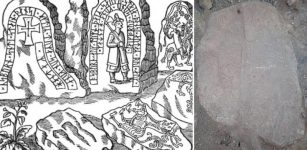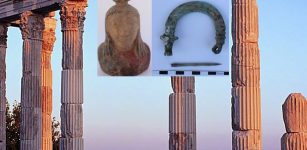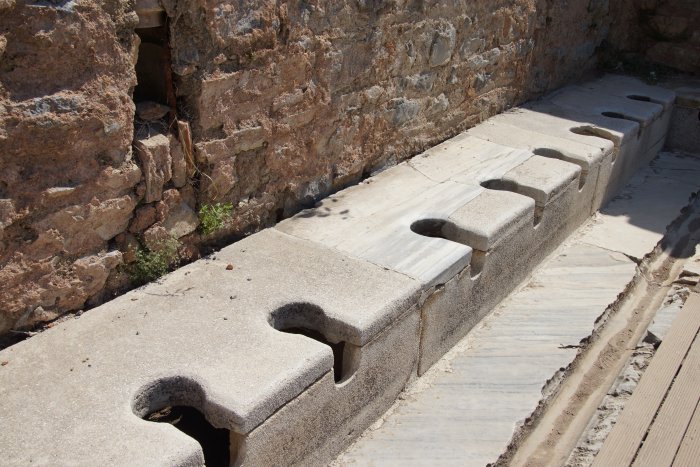First Pay Toilets Were Invented In Ancient Rome In 74 A.D.
Conny Waters - AncientPages.com - The history of the world’s oldest pay toilets can be traced to ancient Rome. Emperor Vespasian was not only the founder of the Flavian dynasty after the civil wars that followed Nero’s death and the initiator of the Roman Colosseum. He was also the man who introduced the first public pay toilets in 74 A.D.
As previously mentioned in our article, the history of bathrooms is thousands of years old and can be traced to ancient Scotland.
Urine tax was common in ancient Rome. Credit: Son of Groucho - Flickr - CC BY 2.0
Around 8,000 B.C., inhabitants of the Orkney Islands built the first latrine-like plumbing systems for carrying wastes away from the home.
However, ancient Romans went further and found a somewhat odd way of making money on public “waste.”
History records several bizarre ancient taxes, and one of them was the urine tax.
In ancient Rome, human urine was a valuable commodity. Urine was used for a variety of reasons, such as tanning, laundering, and even teeth brushing!
Emperor Vespasian (r. A.D. 69-79) and Emperor Nero (r. A.D. 54-68) discovered a golden opportunity to profit from pee. They levied a tax on the acquisition of urine. The result of the urine tax led to the popular Latin phrase Pecunia non alet which means Money does not stink.
Ancient Roman toilets. Credit: Adobe Stock - cascoly2
Emperor Vespasian, who built the Colosseum, was the first to introduce pay toilets in the city of Rome.
Before the first public toilets were introduced, ancient Romans urinated into pots that were emptied into cesspools.
In 74 A.D., Emperor Vespasian re-introduced the urine tax and ordered the construction of public pay urinals, where the waste would be collected and sold as a source of ammonia, which was used for tanning leather and cleaning clothes.
Public urinals are no longer common in Italy, but they are still known as Vespasiani to this day.
In modern times, John Nevil Maskelyne (1839-1917) is credited with the invention of a pay toilet.
John Nevil Maskelyne was an English stage magician, inventor, and a descendant of the Astronomer Royal Nevil Maskelyne.
In the 19th century, Maskelyne invented a lock for London toilets, the insertion of a penny coin to operate it, hence the euphemism to "spend a penny".
Like much of the world, pay toilets were once common in the United States. The majority of pay toilet locks were manufactured by one company, Nik-O-Lok, which charged 10 cents per use. By 1970, America had over 50,000 pay toilets. By 1980, there were almost none because many people felt pay toilets were an unethical infringement on basic human rights.
It took some years, but CEPTIA was successful, and pay toilets were banned in several states.
In Europe, on the other hand, pay toilets are a very common sight. Paying to use a public WC is a European custom that annoys many Americans.
Updated on January 11, 2024
Written by Conny Waters – AncientPages.com Staff Writer
Copyright © AncientPages.com All rights reserved. This material may not be published, broadcast, rewritten or redistributed in whole or part without the express written permission of AncientPages.com
Expand for referencesMore From Ancient Pages
-
 Mysterious Advanced Underground Civilization And A Secret Society – Astonishing Discovery And Connection – Part 1
Ancient Mysteries | Apr 21, 2018
Mysterious Advanced Underground Civilization And A Secret Society – Astonishing Discovery And Connection – Part 1
Ancient Mysteries | Apr 21, 2018 -
 Xochipilli: Aztec God Of Love, Music, Song And Ecstatic Mushroom Trance
Aztec Mythology | May 19, 2018
Xochipilli: Aztec God Of Love, Music, Song And Ecstatic Mushroom Trance
Aztec Mythology | May 19, 2018 -
 America’s First Civilization Was Made Up Of ‘Sophisticated’ Engineers – New Evidence
Archaeology | Sep 2, 2021
America’s First Civilization Was Made Up Of ‘Sophisticated’ Engineers – New Evidence
Archaeology | Sep 2, 2021 -
 Qijia Culture – Its Disappearance Remains An Ancient Mystery
Civilizations | Feb 5, 2021
Qijia Culture – Its Disappearance Remains An Ancient Mystery
Civilizations | Feb 5, 2021 -
 Cartography Shows That The Isthmus Of Tehuantepec Was Used As An Inter-Oceanic Passage In The 16th Century
Archaeology | Oct 21, 2022
Cartography Shows That The Isthmus Of Tehuantepec Was Used As An Inter-Oceanic Passage In The 16th Century
Archaeology | Oct 21, 2022 -
 Wonderful Ancient Mosaics In Ancient City Of Zeugma, Turkey
Archaeology | Dec 12, 2015
Wonderful Ancient Mosaics In Ancient City Of Zeugma, Turkey
Archaeology | Dec 12, 2015 -
 Evil God-Bird Anzu Who Stole The Tablet Of Destiny To Control Universe and Fates Of All
Featured Stories | Aug 8, 2016
Evil God-Bird Anzu Who Stole The Tablet Of Destiny To Control Universe and Fates Of All
Featured Stories | Aug 8, 2016 -
 Ancient Egyptian Knowledge Of The Cosmic Engine And Unseen God Of The Universe
Ancient Mysteries | Jan 15, 2019
Ancient Egyptian Knowledge Of The Cosmic Engine And Unseen God Of The Universe
Ancient Mysteries | Jan 15, 2019 -
 Rare 2000-Year-Old Celtic Figurine Among Finds In Cambridgeshire
Archaeology | Dec 18, 2018
Rare 2000-Year-Old Celtic Figurine Among Finds In Cambridgeshire
Archaeology | Dec 18, 2018 -
 Different Story Of Odin’s Sons Balder And Hoder In Norse Mythology
Featured Stories | Nov 26, 2020
Different Story Of Odin’s Sons Balder And Hoder In Norse Mythology
Featured Stories | Nov 26, 2020 -
 Unique Lost Runestone Of The Hunnestad Monument Finally Found After 300 Years In Sweden
Archaeology | Dec 16, 2020
Unique Lost Runestone Of The Hunnestad Monument Finally Found After 300 Years In Sweden
Archaeology | Dec 16, 2020 -
 Excavations Reveal New Artifacts That Change History Of Ancient City Of Pergamon
Archaeology | Jul 4, 2020
Excavations Reveal New Artifacts That Change History Of Ancient City Of Pergamon
Archaeology | Jul 4, 2020 -
 2,600-Year-Old Blocks Of White Cheese Discovered At Giza’s Saqqara Necropolis, Egypt
Archaeology | Sep 15, 2022
2,600-Year-Old Blocks Of White Cheese Discovered At Giza’s Saqqara Necropolis, Egypt
Archaeology | Sep 15, 2022 -
 2,000-Year-Old Fountain In Kibyra, The City Of Gladiators Flows Again
Archaeology | Jan 3, 2023
2,000-Year-Old Fountain In Kibyra, The City Of Gladiators Flows Again
Archaeology | Jan 3, 2023 -
 5 Different Types Of Priests In Ancient Rome – Their Role And Responsibility Explained
Ancient History Facts | Jan 30, 2018
5 Different Types Of Priests In Ancient Rome – Their Role And Responsibility Explained
Ancient History Facts | Jan 30, 2018 -
 Stunning 2000-Year-Old Roman Silver Dagger Used By Legendary Germanic Warriors Discovered By Teenager
Archaeology | Feb 18, 2020
Stunning 2000-Year-Old Roman Silver Dagger Used By Legendary Germanic Warriors Discovered By Teenager
Archaeology | Feb 18, 2020 -
 Radiocarbon Dating Method Needs Adjustments – Researchers Say
Archaeology | Apr 1, 2020
Radiocarbon Dating Method Needs Adjustments – Researchers Say
Archaeology | Apr 1, 2020 -
 Lost Ancient Greco-Bactrian Kingdom Of 1,000 Cities
Civilizations | Apr 23, 2016
Lost Ancient Greco-Bactrian Kingdom Of 1,000 Cities
Civilizations | Apr 23, 2016 -
 Ancient ‘Cosmic’ Artifacts – Ancient Civilizations Used Meteoric Iron Much Earlier Than Previously Thought
Archaeology | Dec 6, 2017
Ancient ‘Cosmic’ Artifacts – Ancient Civilizations Used Meteoric Iron Much Earlier Than Previously Thought
Archaeology | Dec 6, 2017 -
 Lost Ancient Extraterrestrial Knowledge And The Ignorance Of Modern Man
Ancient Mysteries | Jul 30, 2020
Lost Ancient Extraterrestrial Knowledge And The Ignorance Of Modern Man
Ancient Mysteries | Jul 30, 2020


